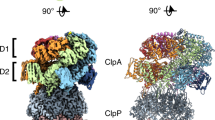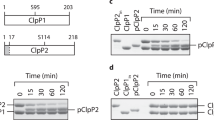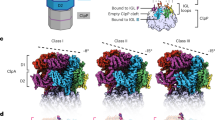Abstract
In the ClpXP compartmental protease, ring hexamers of the AAA+ ClpX ATPase bind, denature and then translocate protein substrates into the degradation chamber of the double-ring ClpP14 peptidase. A key question is the extent to which functional communication between ClpX and ClpP occurs and is regulated during substrate processing. Here, we show that ClpX-ClpP affinity varies with the protein-processing task of ClpX and with the catalytic engagement of the active sites of ClpP. Functional communication between symmetry-mismatched ClpXP rings depends on the ATPase activity of ClpX and seems to be transmitted through structural changes in its IGF loops, which contact ClpP. A conserved arginine in the sensor II helix of ClpX links the nucleotide state of ClpX to the binding of ClpP and protein substrates. A simple model explains the observed relationships between ATP binding, ATP hydrolysis and functional interactions between ClpX, protein substrates and ClpP.
This is a preview of subscription content, access via your institution
Access options
Subscribe to this journal
Receive 12 print issues and online access
$189.00 per year
only $15.75 per issue
Buy this article
- Purchase on Springer Link
- Instant access to full article PDF
Prices may be subject to local taxes which are calculated during checkout








Similar content being viewed by others
References
Ogura, T. & Wilkinson, A.J. AAA+ superfamily ATPases: common structure—diverse function. Genes Cells 6, 575–597 (2001).
Glickman, M.H. et al. A subcomplex of the proteasome regulatory particle required for ubiquitin-conjugate degradation and related to the COP9-signalosome and eIF3. Cell 94, 615–623 (1998).
Gottesman, S., Wickner, S. & Maurizi, M.R. Protein quality control: triage by chaperones and proteases. Genes Dev. 11, 815–823 (1997).
Gottesman, S., Maurizi, M.R. & Wickner, S. Regulatory subunits of energy-dependent proteases. Cell 91, 435–438 (1997).
Bochtler, M., Ditzel, L., Groll, M. & Huber, R. Crystal structure of heat shock locus V (HslV) from Escherichia coli. Proc. Natl. Acad. Sci. USA 94, 6070–6074 (1997).
Groll, M. et al. Structure of 20S proteasome from yeast at 2.4 Å resolution. Nature 386, 463–471 (1997).
Wang, J., Hartling, J.A. & Flanagan, J.M. The structure of ClpP at 2.3 Å resolution suggests a model for ATP-dependent proteolysis. Cell 91, 447–456 (1997).
Wang, J., Hartling, J.A. & Flanagan, J.M. Crystal structure determination of Escherichia coli ClpP starting from an EM-derived mask. J. Struct. Biol. 124, 151–163 (1998).
Bochtler, M. et al. The structures of HsIU and the ATP-dependent protease HsIU-HsIV. Nature 403, 800–805 (2000).
Groll, M. et al. A gated channel into the proteasome core particle. Nat. Struct. Biol. 7, 1062–1067 (2000).
Sousa, M.C. et al. Crystal and solution structures of an HslUV protease-chaperone complex. Cell 103, 633–643 (2000).
Whitby, F.G. et al. Structural basis for the activation of 20S proteasomes by 11S regulators. Nature 408, 115–120 (2000).
Wang, J. et al. Crystal structures of the HslVU peptidase-ATPase complex reveal an ATP-dependent proteolysis mechanism. Structure 9, 177–184 (2001).
Sousa, M.C. & McKay, D.B. Structure of Haemophilus influenzae HslV protein at 1.9 Å resolution, revealing a cation-binding site near the catalytic site. Acta Crystallogr. D 57, 1950–1954 (2001).
Guenther, B., Onrust, R., Sali, A., O'Donnell, M. & Kuriyan, J. Crystal structure of the δ' subunit of the clamp-loader complex of E. coli DNA polymerase III. Cell 91, 335–345 (1997).
Neuwald, A.F., Aravind, L., Spouge, J.L. & Koonin, E.V. AAA+: a class of chaperone-like ATPases associated with the assembly, operation, and disassembly of protein complexes. Genome Res. 9, 27–43 (1999).
Wang, J. et al. Nucleotide-dependent conformational changes in a protease-associated ATPase HsIU. Structure 9, 1107–1116 (2001).
Sousa, M.C., Kessler, B.M., Overkleeft, H.S. & McKay, D.B. Crystal structure of HslUV complexed with a vinyl sulfone inhibitor: corroboration of a proposed mechanism of allosteric activation of HslV by HslU. J. Mol. Biol. 318, 779–785 (2002).
Yoo, S.J. et al. Purification and characterization of the heat shock proteins HslV and HslU that form a new ATP-dependent protease in Escherichia coli. J. Biol. Chem. 271, 14035–14040 (1996).
Seol, J.H. et al. The heat-shock protein HslVU from Escherichia coli is a protein-activated ATPase as well as an ATP-dependent proteinase. Eur. J. Biochem. 247, 1143–1150 (1997).
Ramachandran, R., Hartmann, C., Song, H.K., Huber, R. & Bochtler, M. Functional interactions of HslV (ClpQ) with the ATPase HslU (ClpY). Proc. Natl. Acad. Sci. USA 99, 7396–7401 (2002).
Seong, I.S. et al. The C-terminal tails of HslU ATPase act as a molecular switch for activation of HslV peptidase. J. Biol. Chem. 277, 25976–25982 (2002).
Grimaud, R., Kessel, M., Beuron, F., Steven, A.C. & Maurizi, M.R. Enzymatic and structural similarities between the Escherichia coli ATP-dependent proteases, ClpXP and ClpAP. J. Biol. Chem. 273, 12476–12481 (1998).
Beuron, F. et al. At sixes and sevens: characterization of the symmetry mismatch of the ClpAP chaperone-assisted protease. J. Struct. Biol. 123, 248–259 (1998).
Ortega, J., Singh, S.K., Ishikawa, T., Maurizi, M.R. & Steven, A.C. Visualization of substrate binding and translocation by the ATP-dependent protease, ClpXP. Mol. Cell 6, 1515–1521 (2000).
Kim, Y.I. et al. Molecular determinants of complex formation between Clp/Hsp100 ATPases and the ClpP peptidase. Nat. Struct. Biol. 8, 230–233 (2001).
Singh, S.K. et al. Functional domains of the ClpA and ClpX molecular chaperones identified by limited proteolysis and deletion analysis. J. Biol. Chem. 276, 29420–29429 (2001).
Guo, F., Maurizi, M.R., Esser, L. & Xia, D. Crystal structure of ClpA, an Hsp100 chaperone and regulator of ClpAP protease. J. Biol. Chem. 277, 46743–46752 (2002).
Kim, D.Y. & Kim, K.K. Crystal structure of ClpX molecular chaperone from Helicobacter pylori. J. Biol. Chem. 278, 50664–50670 (2003).
Thompson, M.W., Singh, S.K. & Maurizi, M.R. Processive degradation of proteins by the ATP-dependent Clp protease from Escherichia coli. Requirement for the multiple array of active sites in ClpP but not ATP hydrolysis. J. Biol. Chem. 269, 18209–18215 (1994).
Kim, Y.I., Burton, R.E., Burton, B.M., Sauer, R.T. & Baker, T.A. Dynamics of substrate denaturation and translocation by the ClpXP degradation machine. Mol. Cell 5, 639–648 (2000).
Hwang, B.J., Woo, K.M., Goldberg, A.L. & Chung, C.H. Protease Ti, a new ATP-dependent protease in Escherichia coli, contains protein-activated ATPase and proteolytic functions in distinct subunits. J. Biol. Chem. 263, 8727–8734 (1988).
Gottesman, S., Roche, E., Zhou, Y. & Sauer, R.T. The ClpXP and ClpAP proteases degrade proteins with carboxy-terminal peptide tails added by the SsrA-tagging system. Genes Dev. 12, 1338–1347 (1998).
Singh, S.K., Grimaud, R., Hoskins, J.R., Wickner, S. & Maurizi, M.R. Unfolding and internalization of proteins by the ATP-dependent proteases ClpXP and ClpAP. Proc. Natl. Acad. Sci. USA 97, 8898–8903 (2000).
Kenniston, J.A., Baker, T.A., Fernandez, J.M. & Sauer, R.T. Linkage between ATP consumption and mechanical unfolding during the protein processing reactions of an AAA+ degradation machine. Cell 114, 511–520 (2003).
Wah, D.A., Levchenko, I., Baker, T.A. & Sauer, R.T. Characterization of a specificity factor for an AAA+ ATPase. Assembly of SspB dimers with ssrA-tagged proteins and the ClpX hexamer. Chem. Biol. 9, 1237–1245 (2002).
Wojtyra, U.A., Thibault, G., Tuite, A. & Houry, W.A. The N-terminal zinc binding domain of ClpX is a dimerization domain that modulates the chaperone function. J. Biol. Chem. 278, 48981–48990 (2003).
Flynn, J.M., Neher, S.B., Kim, Y.I., Sauer, R.T. & Baker, T.A. Proteomic discovery of cellular substrates of the ClpXP protease reveals five classes of ClpX-recognition signals. Mol. Cell 11, 671–683 (2003).
Joshi, S.A., Baker, T.A. & Sauer, R.T. C-terminal domain mutations in ClpX uncouple substrate binding from an engagement step required for unfolding. Mol. Microbiol. 48, 67–76 (2003).
Burton, R.E., Baker, T.A. & Sauer, R.T. Energy-dependent degradation: linkage between ClpX-catalyzed nucleotide hydrolysis and protein-substrate processing. Protein Sci. 12, 893–902 (2003).
Singh, S.K., Guo, F. & Maurizi, M.R. ClpA and ClpP remain associated during multiple rounds of ATP-dependent protein degradation by ClpAP protease. Biochemistry 38, 14906–14915 (1999).
Ortega, J., Lee, H.S., Maurizi, M.R. & Steven, A.C. Alternating translocation of protein substrates from both ends of ClpXP protease. EMBO J. 21, 4938–4949 (2002).
Levchenko, I., Luo, L. & Baker, T.A. Disassembly of the Mu transposase tetramer by the ClpX chaperone. Genes Dev. 9, 2399–2408 (1995).
Levchenko, I., Yamauchi, M. & Baker, T.A. ClpX and MuB interact with overlapping regions of Mu transposase: implications for control of the transposition pathway. Genes Dev. 11, 1561–1572 (1997).
Segel, I.H. Enzyme Kinetics: Behavior and Analysis of Rapid Equilibrium and Steady-State Enzyme Systems (Wiley Classics Library edn) 72–74 (Wiley, New York, 1993).
Karon, B.S., Mahaney, J.E. & Thomas, D.D. Halothane and cyclopiazonic acid modulate Ca-ATPase oligomeric state and function in sarcoplasmic reticulum. Biochemistry 33, 13928–13937 (1994).
Acknowledgements
We thank S. Boyd, R. Burton, E. Courtenay, C. Farrell, J. Flynn, R. Grant, J. Kenniston, I. Levchenko, S. Siddiqui and D. Wah for discussion and materials, R. Horvitz and J. King for use of equipment and D. Kim and K. Kim (Sungkyunkwan University School of Medicine, Korea) for the ClpX hexamer coordinates. This work was supported by grants from the US National Institutes of Health and the Howard Hughes Medical Institute (HHMI). T. Baker is an employee of HHMI.
Author information
Authors and Affiliations
Corresponding author
Ethics declarations
Competing interests
The authors declare no competing financial interests.
Rights and permissions
About this article
Cite this article
Joshi, S., Hersch, G., Baker, T. et al. Communication between ClpX and ClpP during substrate processing and degradation. Nat Struct Mol Biol 11, 404–411 (2004). https://doi.org/10.1038/nsmb752
Received:
Accepted:
Published:
Issue Date:
DOI: https://doi.org/10.1038/nsmb752
This article is cited by
-
Targeted DNA integration in human cells without double-strand breaks using CRISPR-associated transposases
Nature Biotechnology (2024)
-
Protein degradation control and regulation of bacterial survival and pathogenicity: the role of protein degradation systems in bacteria
Molecular Biology Reports (2021)
-
Perrault syndrome type 3 caused by diverse molecular defects in CLPP
Scientific Reports (2018)
-
AAA+ chaperones and acyldepsipeptides activate the ClpP protease via conformational control
Nature Communications (2015)
-
Identification of potential mitochondrial CLPXP protease interactors and substrates suggests its central role in energy metabolism
Scientific Reports (2015)



